

Species Profile | Images | Breeding Report | Similar Species
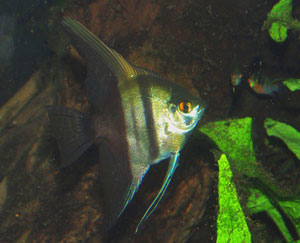
(Other members of the genus Pterophyllum)
ADULT SIZE: 15 cm
WATER CONDITIONS: Moderately soft and acidic
TEMPERATURE RANGE: 24-28 C
FOOD: Feed Pterophyllum scalare live and dried foods
DISTRIBUTION: This species comes from Brazil, Ecuador, Peru
AQUARIUM CARE: A very well-known and easy to care for species. Thrives in a large tank, with a good varied diet. Several different colour forms have been cultivated: black, white, gold, silver, orange, and mixtures of all of these(see the images for some examples). Generally peaceful, although a little more aggressive when spawning.
The angelfish thrives along the Amazon river, and up its tributaries. It lives amongst dense vertical roots where the stripes of the wild-type fish give it perfect camouflage. An aquarium set-up should be well planted at the edges, but also have roots or driftwood, and an open area for swimming. Best kept with peaceful tankmates; other Amazonian species such as tetras are ideal. Avoid fish with any tendancy to fin-nip.
BREEDING: Breeding is possible, with adult pairs spawning on a pre-cleaned leaf, or stone. As with many cichlids, the parents will guard their fry. If spawning takes place in a community aquarium, it is better to remove the spawning site to a seperate rearing tank, as other fish will eat the larvae.
Have you bred Pterophyllum scalare? Why not fill in a breeding questionaire?, or examine existing Pterophyllum scalare breeding reports
LINKS:
fishbase
Other members of the genus Pterophyllum
Other cichlid species
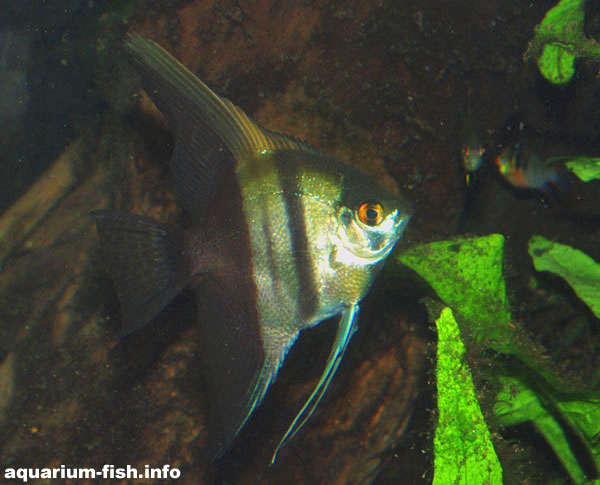
There are many angelfish cultivars; this is the half-black
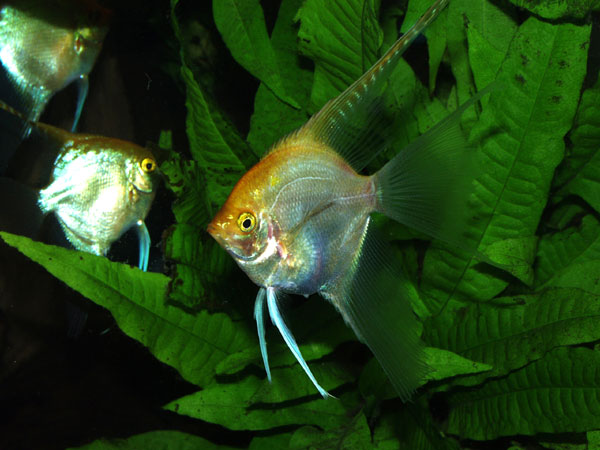
This is the golden strain of angelfish
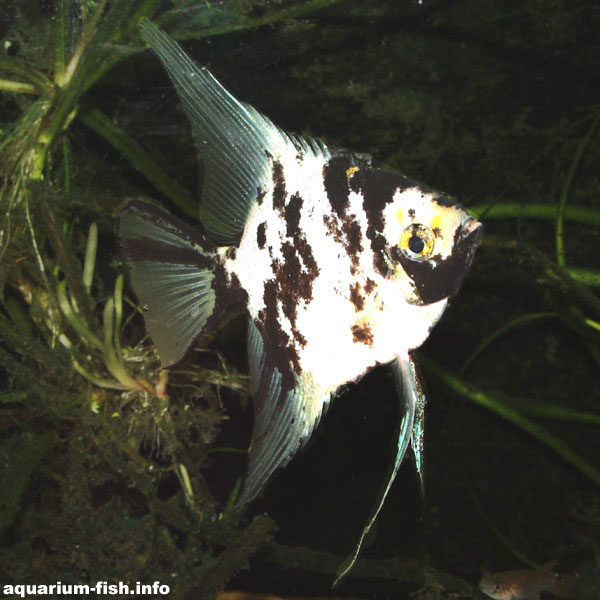
The Marble Angel is one of the most hardy strains
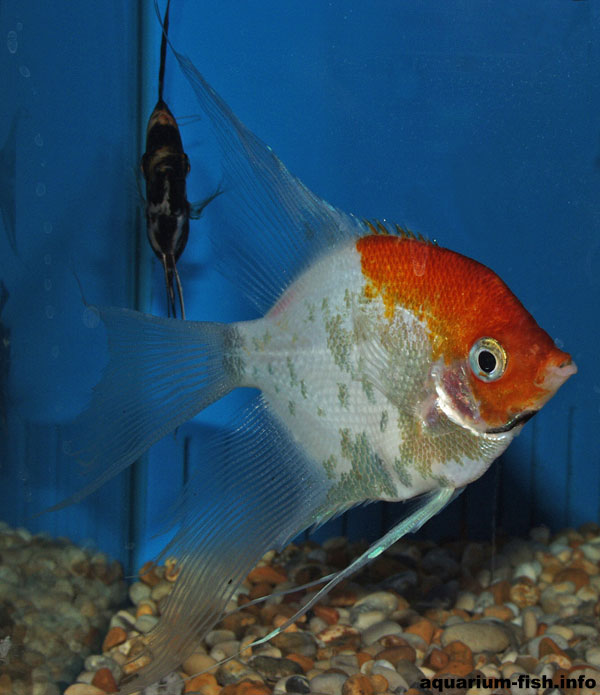
Angel fish cultivars are more widely available than the wild type fish. This is an "orange face" angel.
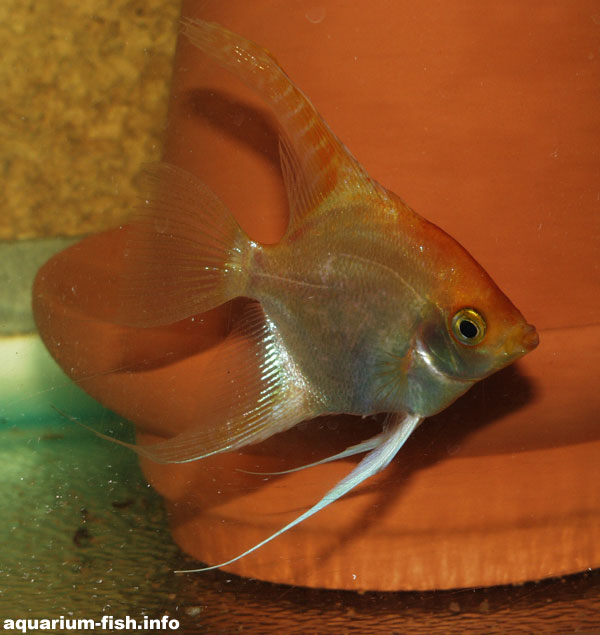
A Gold angelfish in front of a spawning cone; these act as a substrate on which discus and angelfish can spawn
BREEDING: Breeding is possible, with adult pairs spawning on a pre-cleaned leaf, or stone. As with many cichlids, the parents will guard their fry. If spawning takes place in a community aquarium, it is better to remove the spawning site to a seperate rearing tank, as other fish will eat the larvae.
Have you bred Pterophyllum scalare? Why not fill in a breeding questionaire?
This page summarises breeding reports provided by visitors to this site, along with some statistical analysis. Please feel free to contribute - whatever your experience!
| |||||||||
|
| ||||||||
|
| ||||||||
|
| ||||||||
|
| ||||||||
Remember, each record represents only one persons experience; if you had different results, or used different methods, please share your experiences
| Water conditions: Moderately soft and acidic | Water temperature: 24-27oC |
| Disposition: Somewhat aggresive on occasions | Community tank?: Yes, a good community fish |
| Spawning Method: Other (see below) | Breeding problems: Deformities |
| Sex ratio: | Breeding difficulty: Very easy |
| Sucess: Very unsucessful | Years Experience: 6 |
| Other Comments: Slate or leaf with eggs removed from parents tank after the eggs were fertilized. Methaline blue in a small rearing tank until start swimming. Frequent large water changes after that and moving the fry to bigger tanks as they get bigger. Largest hatch I have had is about 500 that made it to juveniles. Average hatch size to juveniles (when I start selling or trading them) is 30-80. | |
| Date this record created: 13th July 2020 | Breeding date: 2020 |
| Breeder: | Location: United States |
| Water conditions: Moderately soft and acidic | Water temperature: 24-27oC |
| Disposition: Somewhat aggresive on occasions | Community tank?: Only with species of similar size |
| Spawning Method: Other (see below) | Breeding problems: Poor fry survival rate |
| Sex ratio: Roughly equal | Breeding difficulty: Easy |
| Sucess: Fairly sucessful | Years Experience: 3 |
| Other Comments: They start their breeding when the water temperature changes a little bit (when cleaning) first they search a good enough leaf which they polish until it's clean. then they lay their eggs on this leaf. which they will guard en keep clean. they protect the babies by taking them in the mouth en when the danger clears they spit out the baby fish | |
| Date this record created: 27th October 2012 | Breeding date: 2010 |
| Breeder: | Location: |
| Water conditions: Very soft and acidic | Water temperature: 28oC+ |
| Disposition: Somewhat aggresive on occasions | Community tank?: Only with species of similar size |
| Spawning Method: Peat (or similar) spawning substrate | Breeding problems: Poor egg survival |
| Sex ratio: | Breeding difficulty: Average |
| Sucess: Very unsucessful | Years Experience: 1 |
| Other Comments: | |
| Date this record created: 24th June 2012 | Breeding date: 2012 |
| Breeder: | Location: Belgium |
| Water conditions: Moderately hard and alkaline | Water temperature: 24-27oC |
| Disposition: | Community tank?: Yes, a good community fish |
| Spawning Method: Adult fish removed from tank | Breeding problems: Poor fry survival rate |
| Sex ratio: Almost all males | Breeding difficulty: Difficult |
| Sucess: Average | Years Experience: 1 |
| Other Comments: | |
| Date this record created: 27th October 2011 | Breeding date: 2011 |
| Breeder: | Location: |
| Water conditions: Moderately soft and acidic | Water temperature: 24-27oC |
| Disposition: Slightly timid | Community tank?: Only with species of similar size |
| Spawning Method: Other (see below) | Breeding problems: Deformities |
| Sex ratio: Roughly equal | Breeding difficulty: Average |
| Sucess: Average | Years Experience: 3 |
| Other Comments: | |
| Date this record created: 10th May 2011 | Breeding date: 2010 |
| Breeder: | Location: |
| Water conditions: Moderately soft and acidic | Water temperature: 24-27oC |
| Disposition: Somewhat aggresive on occasions | Community tank?: Yes, a good community fish |
| Spawning Method: Adult fish removed from tank | Breeding problems: Poor fry survival rate |
| Sex ratio: Roughly equal | Breeding difficulty: Easy |
| Sucess: Fairly sucessful | Years Experience: 1 |
| Other Comments: The first couple spawned on the algae scraper in the community tank shortly after a 25 percent water change. Removed the scraper to a 35 liter breeding tank with the parents. They took great care of the eggs and young fry. Fry are able to consume newly hatched baby brine shrimp when they are all at free swimming stage (about a week after spawning) until when they rely on their own yolk sack. | |
| Date this record created: 3rd March 2011 | Breeding date: 2011 |
| Breeder: Ceyhun | Location: Istanbul |
| Water conditions: Moderately soft and acidic | Water temperature: 24-27oC |
| Disposition: Somewhat aggresive on occasions | Community tank?: Yes, a good community fish |
| Spawning Method: Long term (fry appear with adults) | Breeding problems: none |
| Sex ratio: Roughly equal | Breeding difficulty: Very easy |
| Sucess: Very sucessful | Years Experience: 20 |
| Other Comments: | |
| Date this record created: 30th December 2009 | Breeding date: 2009 |
| Breeder: | Location: |
| Water conditions: Neutral | Water temperature: 28oC+ |
| Disposition: Somewhat aggresive on occasions | Community tank?: Yes, a good community fish |
| Spawning Method: | Breeding problems: Poor egg survival |
| Sex ratio: Almost all males | Breeding difficulty: Easy |
| Sucess: Very unsucessful | Years Experience: 3 |
| Other Comments: I just let them be themselves in a heavily planted tank. The eggs were not removed, so the other fish ate them. This happened 6-7 times in the first 2.5 years. ( 3boys, 1girl)90gal.,27.5degrees | |
| Date this record created: 25th October 2008 | Breeding date: 2007 |
| Breeder: | Location: |